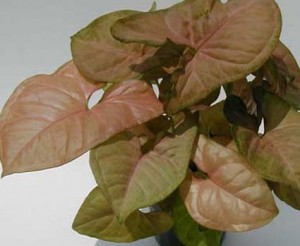Family: Araceae
Synonyms: Nephthytis podophyllum
Distribution & Habitat: is a perennial vine native from Mexico to Panama.
Common Names:
Arrowhead plant, Arrowhead vine, Arrowhead Philodendron, Goosefoot, Trileaf Wonder, African evergreen
Description:
Syngonium podophyllum usually produces medium green, rounded leaves 15 cm long and 10 cm wide with three deep-cut lobes when the plant is young. Mature plants produce leaves up to 30 cm long and wide divided into five or seven segments. There are a number of interesting varieties of Syngonium podophyllum as Syngonium podophyllum neon with extremely bright solid pink - richly saturated colour on each arrowhead leaf.
Proper Care:
Light: Give Syngoniums bright filtered light throughout the year. Never subject them to direct sunlight.
Temperature: Normal room temperatures are ideal. Syngoniums cannot tolerate temperatures below 13 0c.
When never indoor temperatures are above 18C, increase the humidity for actively growing plants by standing pots on trays of moist pebbles.
Watering: Water actively growing plants moderately, allowing the top centimetre or so of the mixture to dry out before watering again. Syngoniums normally have a short winter rest period, during which they should be given only enough water to keep the mixture from drying out completely.
Feeding: Apply standard liquid fertilizer about once every two weeks to actively growing plants.
Potting and repotting: Use an equal parts combination of soil-based potting mixture and coarse leaf mould or peat moss. Repot each Syngonium every spring, moving the plants into pots one size larger when roots have filled the current pots. These plants do not require large containers. A 13 or 15 cm pot or a 15-20 cm hanging basket should be the maximum required. After such a size has been reached, top-dress plants every spring with fresh mixture.
Propagation: Propagate in late spring or early summer from tip cuttings 8-10 cm long. Take each cutting just below a node, strip off the bottom leaf, and dip the cut end in hormone rooting powder. Plant two or three prepared cuttings together in an 8-10 cm pot of a moistened equal-parts mixture of peat moss and coarse sand or perlite. Enclose the whole in a plastic bag or propagating case, and stand it in bright filtered light. After rooting has occurred (normally, in four to six weeks), uncover the pot and begin to give the rooted cuttings just enough water to make the rooting mixture barely moist.
After another month begin to apply monthly doses of standard liquid fertilizer. Four or five months after the start of propagation transfer the young plants, in groups, into the potting mixture recommended for mature specimens and treat them as adult Syngoniums. When transferring the plants keep them together. For hanging baskets it is effective to plant two or three groups in each basket.
Usage
Syngonium can be used as a specimen in small containers up to 22 cm in diameter and the very small plants in cell packs or small individual containers are frequently used in combination planters, such as dish gardens. One of the most popular usage of the plant is in hanging baskets from 14cm to 32 cm diameter. Commercial interiors capers use Syngonium in a variety of other cascading applications and occasionally as ground covers. Although few producers grow it as a totem, it is an excellent candidate for this application.
WARNING
All parts of the Syngonium podophyllum plant are poisonous if eaten.
Begonia propagation f...
Essential Nutrients f...
Portulacaria afra
Tillandsia recurvata
Tillandsia stricta
Columnea microphylla
Clivia miniata
Cleyera japonica
Clerodendrum thomsoni...
Cleistocactus strausi...


